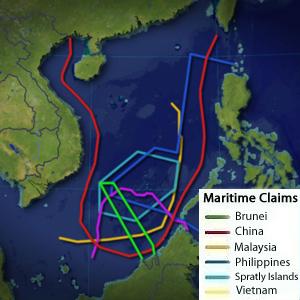
LOTS of tension brewing in the South China Sea
A small two-square-mile island in the South China Sea is finding itself at the center of an alarming multistate power struggle. Yongxing Island, the largest of the Paracel Archipelago, has no indigenous inhabitants of its own and can only be remotely accessed by plane or sea. Tiny and unassuming, it is, rather paradoxically, at the epicenter of a major territorial dispute between the People’s Republic of China and the Philippines.
The PRC recently declared Woody Island, as Yongxing is commonly referred to, a military garrison and began moving troops there this week, much to the chagrin of its neighboring state the Philippines. Echoing his government’s indignation over what are perceived to be threatening acts of Chinese assertiveness, Philippine President Benigno Aquino said three days ago in a speech to the Philippine Congress: “If someone enters your yard and tells you he owns it, will you allow that? It’s not right to give away what is rightfully ours.”
The Paracel Islands are one amongst three resource-rich island groups at the heart of this Southeast Asian Island controversy: the Paracel, Spratly and Macclesfield Bank archipelagos. Five different states extend claims of varying degree over these islands, largely due to the potential wealth of natural resources lying beneath the surrounding ocean’s surface.
As a major regional power, China is taking the lead in asserting its claim, both militarily and politically over the islands and waters in question. This has had a spill-over effect for military preparedness and force escalation in the region in general. In the past year itself, the Philippines, considered one of the weaker states of Southeast Asia, doubled its military defense budget, increasing the overall risk of the territorial dispute.
What is the nature of US involvement in all of this?
As the US administration and military is embarking upon its “pivot to Asia,” the tensions in the South China Sea have tangible repercussions for American interests in the region that extend beyond curbing China’s growing, unchecked power. The pressing question at this moment is whether the US will defend the Philippines if China attacks.
American political and military leadership has hesitated to respond in a black or white, yes or no manner. In June of this year, President Aquino and President Obama met and reaffirmed their commitment to the US-Philippine Mutual Defense Treaty, as well as to peace and security in the Asia-Pacific region, however Washington’s position on intervention is highly contingent on a situational, case-by-case analysis.
Secretary Clinton has often stated, however, that in spite of the tensions between the Southeast Asian states, the United States remains committed to protecting the freedom of navigation, unimpeded commerce and stability in the South China Sea.
To achieve this end, the United States would be best served by ratifying the Law of the Sea Treaty, which would provide US efforts to maintain peace in the region with an honorable mantle of legitimacy. China and the Philippines are both party to the Law of the Sea. Here, I find it worth returning to Admiral Locklear’s testimony from the June 14 Senate Foreign Relations Committee on the Law of the Sea Convention. As Commander of the U.S. Pacific Command, Admiral Locklear emphasized the security benefit LOTS would provide in hotspots such as the South China Sea:
“The Law of the Sea would give us… a framework on [how to deal with] territorial disputes [and] excessive maritime claims. [This framework] is critical to us so that we can maintain our unimpeded access to those areas for the future. We have seven allies in the world. Five of them are in this region. And ensuring that our allies’ perspectives are looked at properly through a rule of law that allows us to continue operate to freely with them is important.”
Since the United States is not party to the Law of the Sea Convention, actors such as China who have much to lose in the event of US intervention are able to effectively shut the door on diplomatic negotiations and bar US participation in the conversation. Undoubtedly, the US has a plethora of methods to make itself heard; however, in the absence of LOTS member status, such methods unfortunately call upon the use of force. As I discussed earlier, there is already a significant and alarming military build-up in the South China Sea.
As Admiral Locklear reiterated throughout the June 14th hearing:
Not ratifying the Law of the Sea Treaty “weakens our standing to object to inappropriate actions of other states that violate the convention. As the United States military executes our rebalance to the Pacific, the convention is essential to locking in a stable, legal framework for the maritime domain that is favorable to our national interests and preserves our access to this critical region.”






[…] LOTS of tension brewing in the South China Sea […]
[…] LOTS of tension brewing in the South China Sea […]
… [Trackback]…
[…] Read More here: americansecurityproject.org/blog/2012/lots-of-tension-brewing-in-the-south-china-sea/ […]…